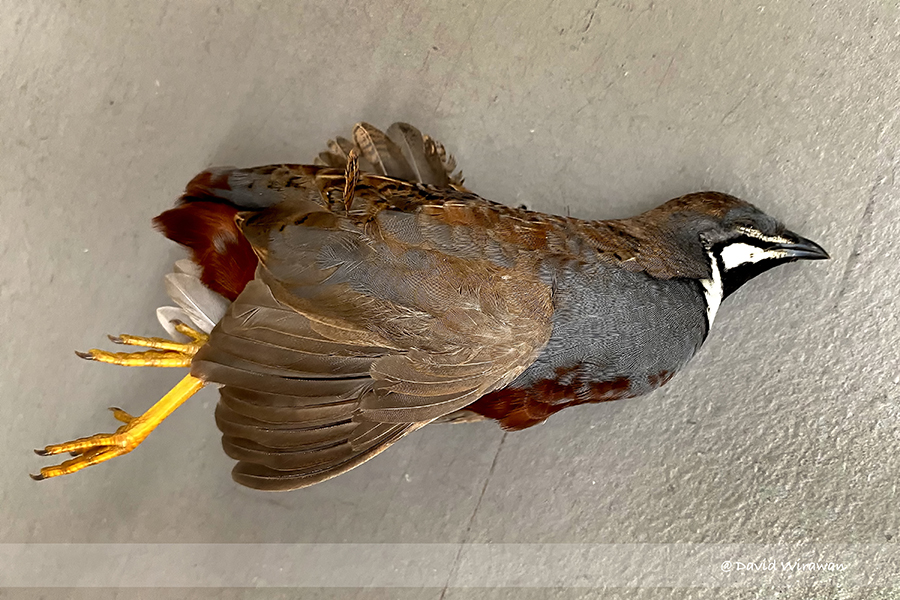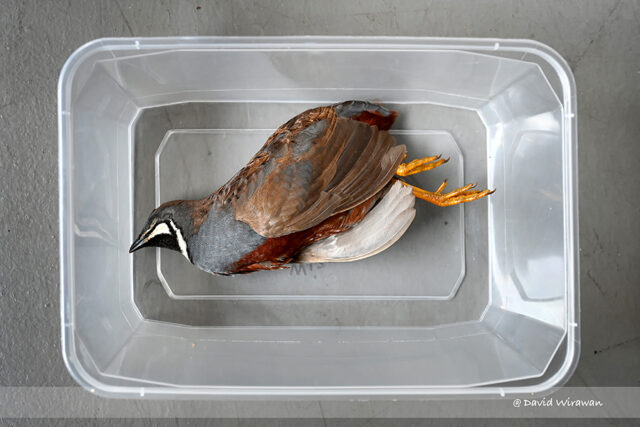On a usual day during the weekend, I may find some beetle or other insects that may be visiting my corridor when I open the door and look outside.
But this time, I saw a bird. It was lying down, and I was not sure if still alive or not. I tried to get closer and realised the bird was dead. Maybe it hit the wall.
I know a bit about some studies/research about bird carcasses. I tried to call the Bird Dead Hotline and mentioned that I found the bird in my corridor and have put it inside the container.
In less than 1 hour, this bid carcass had been picked up.
I am really glad that I can get more information from Yen Yi (NUS Avian Evolution Lab) about this Dead Bird, and here are some questions that I hope can give us more understanding about it.
What do you do with this dead bird, why do you need to examine the bird carcass?
- We photograph the carcass to record its appearance and take biometric measurements, such as the wing length, bill-to-skull and tarsus length. We then subsample the carcass, a process in which a portion of the bird’s breast muscle tissue is carefully excised with a sterile surgical blade, much like a biopsy. The muscle tissue is macerated and immersed in absolute ethanol in a small tube to preserve the DNA it contains. These tubes of tissue are kept in our lab freezers at -20 degrees Celsius for long-term cryostorage. These precious samples contribute to a biorepository by providing a source of preserved DNA and associated plumage and biometric measurements that our researchers and collaborators have access to.
- The remaining carcass can be prepared as skin or parts specimens. Otherwise, we dispose of the unused carcass and its parts as biohazard waste.
- Carcass specimens of rare species are sent to the Lee Kong Chian Natural History Museum collection for future scientific reference.
- We make an effort in collecting dead birds because it is otherwise difficult to obtain specimens for many bird species. Maintaining diverse species representation in our lab repository is crucial in conducting comprehensive avian genetic research, which is our Lab’s main focus.
Can you tell us more about your process of handling the dead bird?
- Our lab maintains a hotline that members of the public can contact when a bird carcass is found. Thereafter, we arrange for a lab member to collect the carcasses if their conditions look salvageable. This hotline is available to contact via Telegram and Whatsapp, at +65 84495023.
- The carcasses are kept in ziplock/airtight plastic bags labelled with their species names and find details, such as time, date and location. We do our best to process the carcasses when they are freshly obtained. But since this is a time-consuming process, the carcasses are stored in a specially designated freezer at -20 degrees Celsius until we are able to process them. We also keep the found details and any associated photographs in a database for future reference.

In Singapore, what is usually the cause of dead birds?
- Most of the carcasses we collect seem to have died upon high-speed collisions with urban structures, especially those with transparent materials, reflective surfaces and night lights which can confuse many birds. For instance, birds cannot see glass very well and can accidentally crash into glass structures at high speeds – many of the carcasses we collect are found near glass windows and doors. This is corroborated by reports by many members of the public, who recount hearing a loud thud prior to finding the bird lying motionless by the structure.
- Even if the bird survives the collision, it usually suffers from some form of a concussion that incapacitates the bird. The bird is then prone to other fatal risks such as predation or may simply die from internal bleeding or bruising.
- Our hotline is especially busy during the migratory season when many birds succumb to Singapore’s skyscrapers. Birds typically migrate at night and seem to rely on light sources for navigation – artificial light sources are known to draw them off-course and cause them to fatally collide into urban structures.
- We would highly recommend members of the public consider bird-safe modifications to glass windows or doors to help out Singapore’s migratory avian visitors. Any installations that make glass structures more visible to birds, such as window decals, mosquito screens, curtains and blinds, one-way privacy films, can tremendously mitigate bird collision risks. We can also do our part in turning off non-essential lights at night as a precaution against confusing migrating birds.
What should we do if we find a dead bird?
- Please Telegram/Whatsapp our hotline at +65 84495023 We will respond as soon as possible and liaise with you.
Please contact via this contact form also - Even if we are unable to collect the bird carcass, the occurrence data will be recorded and will be useful to our lab’s data repository.
Can you tell us more about NUS Avian Evolution Lab?
In the NUS Avian Evolution Lab, our research focuses on harnessing genomic techniques to understand evolutionary mechanisms in nature and to aid conservation work. Our work extends beyond avian research – other organisms our lab has studied (and still does for some!) include pangolins, crocodiles, mosquitoes, horseshoe crabs and even cockroaches!
DEAD BIRD HOTLINE
NUS Avian Evolution Lab at 84495023 or Telegram @deadbirdhotline
Address: Block S3, Level 4, 16 Science Drive 4, 117558.
For more information on how to contact NUS Avian Evolution Lab can visit their website:
https://avianevonus.com/
and can contact them here:
https://avianevonus.com/contact-us-2/














